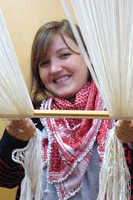Students showcase wearable computing projects, design thinking
Mehdi Shokoueinejad shows off his smart gloves.
Photo: Christian Inouye, Wisconsin Institute for Discovery
Imagine gloves that transmit data from your phone, keeping your hands free. Or a running jacket that monitors your heart rate and lets you know when you’re being followed. What if a garment could respond to its environment?
Students in the School of Human Ecology’s new Wearable Computing course brought these imaginations to reality as they presented their creations to the public at Nancy Nicholas Hall last week.

Emelia Haglund
Taught by Kevin Ponto, assistant professor in Design Studies and the Wisconsin Institute for Discovery’s (WID) Living Environments Laboratory, and Emelia Haglund, associate lecturer in Textile and Apparel Design, the class provides students with hands-on experience in building wearable computing platforms. Students from textile and apparel design, biomedical engineering, computer science and industrial engineering have studied the fundamentals of textiles, circuitry and microcontroller programming while integrating art, design and science.
“Students explore how we can turn wearables into an interface,” says Ponto, whose own work focuses on integrating physical and virtual worlds. “The students create objects that communicate between users and computers, providing feedback and opening the lines of more natural interactions.”
Maddie Gibson, a graduate student in industrial engineering in the class, gained inspiration for her “smart running jacket” from participating in the Ragnar Relay race, an overnight run from Madison to Chicago.
This glowing dress lights up when triggered by music. Photo: Christian Inouye
“I ran at night with a big head lamp and reflective jacket on — it was really uncomfortable,” she says. “I thought there might be a way to incorporate safety lighting more seamlessly.”
LED lights are sewn down the shoulders and sleeves of Gibson’s jacket, where they illuminate for other runners and cars to see. But when another runner or person comes within a certain distance behind the jacket, a sensor triggers the lights to begin flashing to make its owner aware of another person or object nearby. Near the wrist of the jacket’s sleeve, another sensor measures the runner’s heart-rate, changing colors when the person is at, above or below their desired threshold.
“This class has really allowed me to apply design principles I’ve learned in industrial engineering to real-word applications,” Gibson says. “There are not many opportunities to do this type of rapid-prototyping.”
These new methods of human-computer interaction play an increasingly important role in society, as technology becomes more integrated in everyday living.

Kevin Ponto
“We seem to be on the cusp of a wave that is going to potentially be a big consumer market,” Ponto says. “A great deal of enthusiasm has spurred many start-up companies creating wearable computing technology.”
Mehdi Shokoueinejad and Alper Sarikaya, graduate students in biomedical engineering and computer sciences respectively, have prototyped wireless gloves that in coordination with an Android app can display smart phone data on the glove’s screen. The duo has developed an auto-response the user can activate to indicate the person trying to be reached is unable to answer in certain circumstances when the user is driving or biking.
Another project led by computer science graduate student Nathan Mitchell focuses on creating wrist bands that transfer people’s business card information to each other upon shaking hands, while student and swimmer Zach Mueller’s created a waterproof armband to measure physical activity in the water.
Other projects focus less on physical activity and are more rooted in art and performance.
“It’s a fun, participative class. We’re always helping each other out, and as a result, we’re learning a lot. ”
Jessica Frantal
Jessica Frantal, a graduate student in design studies, hand-crafted a “lightning dress” to make its debut during her role in an upcoming 18th-century take on the play the Wizard of Oz. Her character? The tornado that spins through Dorothy’s Kansas home.
Frantal says she enjoyed working with others outside her field.
“It’s a fun, participative class,” she says. “We’re always helping each other out, and as a result, we’re learning a lot.”
Undergraduate textile and apparel design majors Alix Ambur and Meghan Martine both incorporated LED lights into their dress and scarf projects, each serving fashion and function for the user.
“The collaborative nature of the class is remarkable,” Haglund says. “It’s really rewarding to see the two groups share information.”
The class typifies the work and real-world impact SoHE is having on design and technology development.
“Wearable Computing is an excellent example of Design Thinking and supports the Human Ecology initiative to collaborate on innovative solutions to real-world problems,” says Human Ecology Dean Soyeon Shim. “This human-centered approach begins with empathy, encompasses collaborative creativity, and continues through prototyping and testing to ensure the best possible answers to today’s challenging questions.”
Haglund hopes the course bridges the distance between Design Studies and other departments to enable the students to branch out across campus, expanding their knowledge base, and ultimately, becoming more successful.
“Moving forward, we’d love to have students from art, theater, and other scientific disciplines making this a universal course,” she says.
– Doris Green and Marianne English

